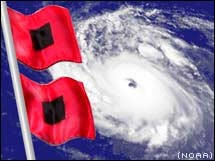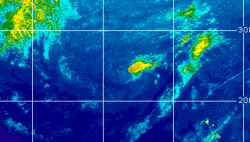Ed Dunham
Former Meteorologist & CFHC Forum Moderator (Ed Passed Away on May 14, 2017)
Reged:
Posts: 2565
Loc: Melbourne, FL
|
|
Models are not too divergent at the moment on the anticipated path of Tomas through the Caribbean Sea. This is the place for you to post your thoughts on the eventual track and intensity of what is likely to become Hurricane Tomas - the 12th hurricane of the season.
ED
|
berrywr
Weather Analyst

Reged:
Posts: 387
Loc: Opelika, AL
|
|
The following analysis is based on the 30/00Z run.
It is difficult to locate a center on satellite early this morning, however the broader circulation is moving more NW than WNW and current movement supports the .
I'm having a hard time accepting 's future track positions given the current environment and future environment. Currently there is a trough south of Bermuda extending SSW between Hispaniola and Cuba to a closed low near 17.0N and 79.5W.
Goes Shear Analysis confirms there is a bulls eye of 60 knots of shear between Hispaniola and PR with axis extending NE and SW where isotachs of 50, 40 and 30 knots extend just offshore of Panama. Currently winds of 10 to 15 knots are located over Tomas. Upper level ridge currently over the TX/LA coast.
Models have a vigorous shortwave moving south and east along the front side of the trough in 5 days which will extend from a potent upper low over the New England area extending south-south west to what will become a strong inverted and cutoff low near the TX/LA/GOM border with strong westerlies extending as far south as 25N latitude. This scenario will create considerable gradience and shear SE of this trough.
The only fly in the ointment is whether this longwave trough will pick up Tomas and I am in the camp that believes it will given it's strength, the calendar and position. I don't believe Tomas will move any farther west than south of Hispaniola where re-curvature is likely to occur if not before near PR. Steering currents will likely weaken and Tomas will remain near PR and Hispaniola for an extended amount of time before the longwave trough picks Tomas up and carries it out into the North Atlantic as an extra-tropical system in due time.
Intensity...difficult to pinpoint but given it's current satellite presentation, SSTs of 28 and 29C and position it can't be dismissed that Tomas will likely be a major hurricane within the next 24 to 36 hours. Tomas for the moment is well south and will have an opportunity to strengthen before gaining enough latitude to feel the westerlies and the calendar.
We cannot dismiss the imminent danger this hurricane is likely to pose for the country of Haiti and her citizens.
.
--------------------
Sincerely,
Bill Berry
"Survived Trigonometry and Calculus I"
|
doug
Weather Analyst
Reged:
Posts: 1006
Loc: parrish,fl
|
|
I think your analysis is consistent with the solution. None of the major models take the system west of 72 before taking it north, either across Hispanola or eastern Cuba.
--------------------
doug
|
danielw
Moderator

Reged:
Posts: 3527
Loc: Hattiesburg,MS (31.3N 89.3W)
|
|
The current satellite storm center appears to be NE of the RECON wind center... by at least 100 miles.
This could throw a wrench in the 12Z forecast.
Will have to wait on RECON to complete the rest of the Center Fix.
Will the mountains of the Lesser Antilles shear Tomas apart as he moves into the Hurricane Graveyard of the Eastern Caribbean?
Edited by danielw (Sat Oct 30 2010 07:32 AM)
|
MichaelA
Weather Analyst

Reged:
Posts: 956
Loc: Pinellas Park, FL
|
|
Quote:
Will the mountains of the Lesser Antilles shear Tomas apart as he moves into the Hurricane Graveyard of the Eastern Caribbean?
I doubt they will have very much influence, since they are few and spread out and not all that high. A very small storm would probably show some fluctuation from them, but Tomas is rather large, so it won't even blink.
--------------------
Michael
PWS
|
berrywr
Weather Analyst

Reged:
Posts: 387
Loc: Opelika, AL
|
|
Both the and have performed terrific this season. In answer to the mountains question, a large circulation with the center well out over water is unaffected by terrain with one exception...a center near landfall with its circulation over land; in this scenario it could be disrupted.
--------------------
Sincerely,
Bill Berry
"Survived Trigonometry and Calculus I"
|
MichaelA
Weather Analyst

Reged:
Posts: 956
Loc: Pinellas Park, FL
|
|
That was an interesting jog around St. Vincent as seen on the French Antilles radar loop. Tomas is still strengthening and developing a rather impressive organization. The short term track still carries it WNW to south of Hispaniola where it may slow before making that northward turn. That's not good news for Haiti since housing in and around Port-au-Prince is still in a shambles. Tomas may well be a major hurricane at that point as well.
EDIT: The latest sat pics indicate that there is dry air being entrained from the South, so that may inhibit some intensification in the short term.
--------------------
Michael
PWS
Edited by MichaelA (Sat Oct 30 2010 07:49 PM)
|
Ed Dunham
Former Meteorologist & CFHC Forum Moderator (Ed Passed Away on May 14, 2017)
Reged:
Posts: 2565
Loc: Melbourne, FL
|
|
Tomas currently moving slowly westward in the eastern Caribbean Sea as a Cat II Hurricane, however, southwesterly shear should curtail the current intensification and some slow weakening is possible over the next couple of days. Beyond that timeframe the windshear is expected to abate somewhat which should allow Tomas to again intensify. Tomas likely to turn more northerly mid-week with probable impact on Haiti late Thursday and the Turks & Caicos on Friday. Perhaps a threat to Bermuda next weekend as a much weaker system. Interesting that the keeps Tomas (or its cutoff low) around well into November.
ED
|
MichaelA
Weather Analyst

Reged:
Posts: 956
Loc: Pinellas Park, FL
|
|
Tomas downgraded to Cat I (90 MPH) at 11 AM ET due to shear and dry air intrusion. The vis sat signature is rather ragged for now. The shear is forecast to relax in a couple of days and strengthening should resume. It does appear that a new feeder is trying to form on the southern side in the WV loop.
EDIT: As of the 5 PM ET Advisory, Tomas is further weakened to 75 MPH sustained and may even weaken to TS strength by tomorrow AM, still due to the shear and dry air intrusion. The intensity forecast has been lowered as well, with Tomas probably not gaining major status in the next 5 days.
--------------------
Michael
PWS
Edited by MichaelA (Sun Oct 31 2010 05:03 PM)
|
Rosy
Registered User

Reged:
Posts: 9
Loc: Charlotte, NC
|
|
The last two advisories have shown weakening. What changed from the further stregthening forecast?
Post moved to possibly more appropriate thread.
- Ciel
Edited by cieldumort (Sun Oct 31 2010 09:35 PM)
|
cieldumort
Moderator

Reged:
Posts: 2664
Loc: Austin, Tx
|
|
Quote:
The last two advisories have shown weakening. What changed from the further stregthening forecast?
That's a very good question!
The does a pretty good job explaining it during the 5PM Discussion:
Quote:
SOME ADDITIONAL WEAKENING SEEMS LIKELY DURING THE NEXT DAY OR AS
SOUTHWESTERLY SHEAR OF 20-25 KT AND SOME MID-LEVEL DRY AIR CONTINUE
TO IMPACT THE CYCLONE. THE OFFICIAL FORECAST FOLLOWS THE TREND IN
THE GUIDANCE AND IS ONCE AGAIN ADJUSTED DOWNWARD...BRINGING TOMAS
BELOW HURRICANE STRENGTH WITHIN THE NEXT 12 HOURS. BEYOND A COUPLE
OF DAYS...THE SHEAR IS EXPECTED TO LESSEN WHILE TOMAS REMAINS OVER
FAVORABLE OCEANIC CONDITIONS. ALL OF THE INTENSITY MODELS RESPOND
AND SHOW THE SYSTEM INTENSIFYING IN THE 3 TO 5 DAY RANGE...AND THE
OFFICIAL FORECAST FOLLOWS SUIT AND IS AT THE HIGH END OF THE
GUIDANCE THROUGHOUT THE FORECAST PERIOD.
(LINK)
In general, tropical cyclones benefit from air currents that do not disturb their cyclonic flow, and also that do not interrupt any anticyclonic flow that exists above them. The shear that the speaks of is currently working against Tomas in this regard, as well as allowing some drier air to penetrate the system, which is further damaging to tropical cyclones.
Hope that helps!
|
MichaelA
Weather Analyst

Reged:
Posts: 956
Loc: Pinellas Park, FL
|
|
Some convection is trying to develop nearer the LLC as seen in the latest Floater Vis pic (1245 UTC). We'll see if that will continue or be sheared off as time goes on.
EDIT: As of the 1415 UTC pic, shearing off to the NE.
--------------------
Michael
PWS
Edited by MichaelA (Mon Nov 01 2010 11:14 AM)
|
Rosy
Registered User

Reged:
Posts: 9
Loc: Charlotte, NC
|
|
It certainly does help. Thank you!
--------------------
Survived:
Andrew '92 (Miami)
Charley '04 (Ft. Myers) (& weak side of Frances, Jeanne)
Wilma '05 (Ft. Myers)
|
berrywr
Weather Analyst

Reged:
Posts: 387
Loc: Opelika, AL
|
|
Using ....
At 01/00Z last night there was a broad upper low over all of Central America with relatively small shortwaves rotating from south to north around. There is a broad upper high axis generally extending east and west from multiple centers at 25.0N 82.5W and again at 24.0N and 79.0W. The trough in the SW Atlantic has dissipated.
At 01/12Z the inverted trough near Yucatan had become positive tilted...that is as a trough you see advancing east and south bulging east; not inverted like easterly waves with the bulge facing west. Easterly waves almost always have their weather behind the wave; not in front where conventional shortwaves over the US have their weather in front where positive vorticity creates rotation and lift.
The H=12 hours valid time 02/00Z has this wave cutting off and forming an upper low over the Yucatan Peninsula. We use the 200mb Upper Air Analysis(UAA) for outflow however we do use the 300mb UAA as we progress towards winter...as the environment becomes progressively colder; thickness decreases thus heights fall. I had a terrible time in USAF Weather Forecast School understanding this...the best way I can describe this to all is a stand up freezer; you open it and all that dense cold air comes tumbling out; where as a chest freezer only mixes at the top, not the bottom. When that cold air tumbles out imagine it were a balloon with a surface you can see; maybe blue-clear. The edge or surface of the balloon is a constant pressure that its edge either expands with heat or contracts with cold. As the westerlies sink south you will note the heights of these constant pressures also drift south. Ever ask yourself how forecasters know where the rain/snow line is; thickness, the magic number being 546 or 5460 decameters...back to hurricanes.
There is a gradience between these tropical features that is generating shear between the two and it is this wind that has Tomas decoupled...that is its mid-level circulation is tilted or separated to the NE of the surface.
Future track of Tomas....
Begins along the West Coast of the US as a strong jet maxima in excess of 160 knots will dive between the upper closed high off California and a deepening trough along the East Coast in the next few days; this piece of energy will carve a cutoff low over Eastern TX. A second piece of energy will move east and deepen the upper low and adjacent long wave trough. This second piece will kick the cutoff low over the GOM and as it does so surface cyclogenesis will occur along a surface front and deepen as it moves up the coast. This in turn will recurve and kick Tomas NE with possible extra-tropical transition and become absorbed into the frontal zone.
--------------------
Sincerely,
Bill Berry
"Survived Trigonometry and Calculus I"
Edited by berrywr (Mon Nov 01 2010 05:41 PM)
|
MichaelA
Weather Analyst

Reged:
Posts: 956
Loc: Pinellas Park, FL
|
|
Very nice analysis. Also, note that the convection has been reforming over Tomas' LLC all afternoon today.
--------------------
Michael
PWS
|
srquirrely
Weather Watcher

Reged:
Posts: 33
Loc: SARASOTA
|
|
When you say...
Quote:
...windshear reduced Tomas to a low level swirl that was displaced from its convection by over 100 miles
do you mean that the LLC at @ 13/69 and COC at @ 12/65 are all 'of a piece'?? 
|
Ed Dunham
Former Meteorologist & CFHC Forum Moderator (Ed Passed Away on May 14, 2017)
Reged:
Posts: 2565
Loc: Melbourne, FL
|
|
Well no - since satellite images are highly perishable, i.e., they can change significantly with time. If you didn't see the structure of Tomas this morning I can see where my comments might be a bit confusing.
This morning Tomas was just a swirl of low-level clouds and all of the heavy convective storm clouds had been shoved off to the northeast of the center of the low cloud swirl by a distance of at least 100 miles. Strong southwesterly winds at the mid and upper levels of the atmosphere had caused this decoupling of the low level center from its convective cloud mass. Earlier this afternoon, the southwesterly winds began to decrease and the convection began to build back toward the center of the low level swirl of Tomas. Now that the convection has developed back over the low level center, additional weakening is not likely - at least not for awhile.
ED
|
berrywr
Weather Analyst

Reged:
Posts: 387
Loc: Opelika, AL
|
|
This morning, Tomas had decoupled with the low level circulation exposed and convection and mid-level vorticity well to the east; in fact, there were two thunderstorm complexes removed from one another and both well removed from the center of circulation..
5 pm ET discussion is out....I'm fine with their thinking.
Excerpt from the 2 pm Tropical Discussion....
GULF OF MEXICO...
WATER VAPOR IMAGERY AND UPPER AIR SATELLITE DERIVED WINDS NDICATE A WEAK ELONGATED UPPER LEVEL LOW/TROUGH CENTERED FROM THE WESTERN YUCATAN PENINSULA TO THE SW GULF. HOWEVER...THIS FEATURE REMAINS EMBEDDED IN VERY DRY AND STABLE AIR. THE SAME PRODUCT DISPLAYS MOSTLY WESTERLY ZONAL UPPER LEVEL FLOW N OF 24N. UPPER LEVEL MODEL DATA INDICATES A 70 KT JET-STREAK DEVELOPING OVER THE FAR NW GULF...LIKELY RESPONSIBLE FOR AN LINE OF SCATTERED MODERATE TO HEAVY SHOWERS AND ISOLATED
THUNDERSTORMS MOVING ALONG THE EASTERN TEXAS COAST AND WESTERN LOUISIANA COAST BETWEEN GALVESTON ISLAND TO MARSH ISLAND RESPECTIVELY. THIS UPPER LEVEL JET ENHANCES A SHORTWAVE THAT SUPPORTS A LOW PRESSURE SYSTEM OVER E TEXAS...EXPECTED TO INTRODUCE A COLD FRONT INTO THE NW GULF BY TUESDAY WITH STRONG NORTHERLY WINDS BEHIND THE FRONT.
--------------------
Sincerely,
Bill Berry
"Survived Trigonometry and Calculus I"
|
weathernet
Storm Tracker
Reged:
Posts: 296
Loc: Elsewhere
|
|
Fascinating...., take a look on the IR2 satellite late this evening, at roughly 11 N and 64 W I have attached a link for this infrared loop ( http://www.ssd.noaa.gov/goes/flt/t2/flash-ir2.html ). I would appear that the cluster of convection just north of the South America in the S.E. Carib. now nearly eroded, has exposed what was a fairly impressive vorticity; perhaps a good deal more appearant than our storm at the moment. Interesting feature. 
|



 Threaded
Threaded










